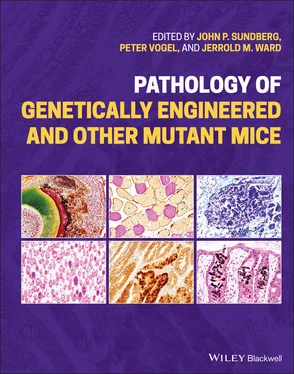Pathology of Genetically Engineered and Other Mutant Mice
Здесь есть возможность читать онлайн «Pathology of Genetically Engineered and Other Mutant Mice» — ознакомительный отрывок электронной книги совершенно бесплатно, а после прочтения отрывка купить полную версию. В некоторых случаях можно слушать аудио, скачать через торрент в формате fb2 и присутствует краткое содержание. Жанр: unrecognised, на английском языке. Описание произведения, (предисловие) а так же отзывы посетителей доступны на портале библиотеки ЛибКат.
- Название:Pathology of Genetically Engineered and Other Mutant Mice
- Автор:
- Жанр:
- Год:неизвестен
- ISBN:нет данных
- Рейтинг книги:3 / 5. Голосов: 1
-
Избранное:Добавить в избранное
- Отзывы:
-
Ваша оценка:
- 60
- 1
- 2
- 3
- 4
- 5
Pathology of Genetically Engineered and Other Mutant Mice: краткое содержание, описание и аннотация
Предлагаем к чтению аннотацию, описание, краткое содержание или предисловие (зависит от того, что написал сам автор книги «Pathology of Genetically Engineered and Other Mutant Mice»). Если вы не нашли необходимую информацию о книге — напишите в комментариях, мы постараемся отыскать её.
An updated and comprehensive reference to pathology in every organ system in genetically modified mice Pathology of Genetically Engineered and Other Mutant Mice
Pathology of Genetically Engineered and Other Mutant Mice
Pathology of Genetically Engineered and Other Mutant Mice — читать онлайн ознакомительный отрывок
Ниже представлен текст книги, разбитый по страницам. Система сохранения места последней прочитанной страницы, позволяет с удобством читать онлайн бесплатно книгу «Pathology of Genetically Engineered and Other Mutant Mice», без необходимости каждый раз заново искать на чём Вы остановились. Поставьте закладку, и сможете в любой момент перейти на страницу, на которой закончили чтение.
Интервал:
Закладка:
3 Chapter 4 Table 4.1 Criteria for accurately defining an animal model, regardless of h...
4 Chapter 5 Table 5.1 Common embryonic or neonatal defects leading to lethality. Table 5.2 Common placental defects leading to embryonic lethality.
5 Chapter 7 Table 7.1 Defects in thymus development in genetically engineered mice. Table 7.2 Defects in the development of secondary lymphoid tissues in genet...
6 Chapter 8 Table 8.1 Myeloid leukemia associated with conventional mice and mouse mode...Table 8.2 Nonlymphoid hematopoietic sarcomas associated with conventional m...Table 8.3 B‐cell lymphoid neoplasms associated with conventional mice and m...Table 8.4 T‐cell lymphoid neoplasms associated with conventional mice and m...
7 Chapter 9Table 9.1 Common genetic mutations in immunodeficient strains used in biome...Table 9.2 A comparison of advantages and disadvantages offered by PDX model...Table 9.3 Clostridioides difficile ‐induced lesions in different mouse strains.Table 9.4 Historically recognized pathogens – effects in immunodeficient mo...Table 9.5 Neoplastic, degenerative, and miscellaneous lesions in immunodefi...
8 Chapter 10Table 10.1 Functions of the skin.Table 10.2 Comparisons of structures and functions of skin and adnexa betwe...Table 10.3 Classification of primary scarring (cicatricial) alopecias.Table 10.4 Human ichthyosiform dermatoses and mouse orthologs.Table 10.5 Nonmelanoma skin cancers in mice by induction method.Table 10.6 Mouse models for the various forms of human Epidermolysis Bullos...
9 Chapter 11Table 11.1 Breast cancer genes and mouse models.
10 Chapter 12Table 12.1 Antibodies used to evaluate mouse lung by immunohistochemistry i...Table 12.2 Examples of genetic based human lung diseases for which mouse mo...Table 12.3 Examples of mouse genes that when mutated create models for gene...Table 12.4 Examples of lung tumors from targeting single or combined driver...Table 12.5 Classification of proliferative lung lesions of mice.
11 Chapter 13Table 13.1 Examples of mouse models of heritable and non‐heritable human ga...Table 13.2 Role of genes in enteritis and colitis in humans and mice.Table 13.3 Common molecular pathways in human colorectal carcinogenesis.Table 13.4 Examples of mouse models of human heritable cancer syndromes ass...Table 13.5 Nomenclature of mouse glandular stomach and intestinal epithelia...Table 13.6 Features helpful in distinguishing invasive adenocarcinoma from ...
12 Chapter 14Table 14.1 Immunohistochemical markers useful for evaluating the cardiovasc...Table 14.2 Genetically engineered mice (GEMs) models of heart disease: revi...Table 14.3 Genes that have been engineered in mice to produce models of vas...
13 Chapter 15Table 15.1 Mouse liver immunohistochemistry.Table 15.2 Relevant GEM models for human nonneoplastic liver diseases.Table 15.3 Relevant GEM models for human neoplastic liver diseases.Table 15.4 Most commonly diagnosed hepatic proliferative lesions found in m...Table 15.5 Useful immunohistochemical markers and their reactivity in diffe...Table 15.6 Major genetic alterations, their type of mutation, and their occ...Table 15.7 Mouse models of human hereditary pancreatitis.Table 15.8 Common genes used to drive expression in genetic models of exocr...Table 15.9 Classification and grading of mouse and human pancreatic intradu...Table 15.10 Human pancreatic cancer genetics and mouse models of human PDAC...
14 Chapter 16Table 16.1 Mouse models: neurogenic myopathies.Table 16.2 Mouse models: myogenic myopathies.
15 Chapter 17Table 17.1 Selected hereditary human endocrine cancer syndromes and GEM aph...
16 Chapter 18Table 18.1 Examples of strain‐specific lesions and phenotypes of the renal ...Table 18.2 Common laboratory mouse strains: degree of susceptibility to exp...Table 18.3 Clinical chemistry testing in evaluation of mice for kidney dise...Table 18.4 Selected pathology stains and methods.Table 18.5 Mean glomerular numbers per kidney in adult mice. aTable 18.6 Major causes of nephrotic and nephritic syndromes in humans. aTable 18.7 Nephrotic and other proteinuric glomerular diseases modeled in t...Table 18.9 Examples of mouse models of human glomerular nephritic diseases.Table 18.10 Spontaneous tubular lesions in mice. aTable 18.11 Selected genetic tubular diseases, including cystic diseases, m...Table 18.12 Phenotypes of selected human kidney cancer genes and of genetic...
17 Chapter 19Table 19.1 Common immunohistochemical markers.Table 19.2 Major genetic alterations affecting gonadal structure or functio...Table 19.3 Some major models for studying human female reproductive tract d...
18 Chapter 20Table 20.1 Classification of lesions of the prostate in genetically enginee...Table 20.2 Select GEM models of prostate cancer.Table 20.3 Selected immunohistochemical markers to identify different cell ...Table 20.4 Examples of GEM models of male infertility/subfertility with cor...Table 20.5 Examples of GEM models of male infertility/subfertility with cor...
19 Chapter 21Table 21.1 Functional regions of the central nervous system.Table 21.2 Main cell types of the central nervous system.Table 21.3 Examples of spontaneous strain‐specific lesions in the mouse.Table 21.4 Examples of age‐related lesions in the mouse.Table 21.5 Quick guide to the pros and cons of commonly used AD mouse model...Table 21.6 Commonly used mouse models of amyotrophic lateral sclerosis and ...Table 21.7 Mouse models of spinocerebellar ataxia and cerebellar mutants.Table 21.8 Selected mouse models for study of EAE.Table 21.9 Selected mouse models of lysosomal storage diseases.Table 21.10 Spontaneous and genetically engineered mouse models of epilepsy...
20 Chapter 22Table 22.1 Select list of inbred mouse strains with a Pde6b rd1mutation.Table 22.2 Genes and spontaneous mutations of the laboratory mouse eye that...Table 22.3 Selected genetically engineered and mutant mice for glaucoma and...Table 22.4 Select genetically engineered and mutant mice for with hearing a...
List of Illustrations
1 Chapter 1 Figure 1.1 Classes of proteins associated with human genetic diseases.
2 Chapter 2 Figure 2.1 Data integration strategy for Monarch. Data, mainly “genotype‐to‐... Figure 2.2 The Mouse Models of Human Cancer Database (MMHC), formerly Mouse... Figure 2.3 IMPC phenotyping pipelines for adult mice (17 weeks) and embryos... Figure 2.4 The histopathology browser for the IMPC database. Data can be sea...
3 Chapter 3 Figure 3.1 Top, searching p53 SNPs reveals “The gene you selected is not in... Figure 3.2 Finding the gene and allele symbol on Mouse Genome Informatics.O... Figure 3.3 Current symbols assigned to a variety of unrelated genes original... Figure 3.4 Nomenclature for hybrid stocks. Figure 3.5 Setting up a mapping cross using F1 and F2 hybrids. Figure 3.6 Crossing AKR/J mice with more than one inbred strain to map the m... Figure 3.7 Using recombinant inbred lines to narrow candidate gene intervals...
4 Chapter 4 Figure 4.1 Nonhuman (including mouse) models were historically compared empi... Figure 4.2 Human population response to disease is often highly variable bet... Figure 4.3 Effect of strain on phenotype for a single gene mutation. A class... Figure 4.4 Mouse models identify subtypes of junctional epidermolysis bullos... Figure 4.5 Fitting mouse models to the concepts of human disease. The mouse ... Figure 4.6 Validation of mouse models over time. In 1989 few mouse models ac...
5 Chapter 5 Figure 5.1 Composite image of embryonic mouse developmental stages from just... Figure 5.2 Mouse embryo littermates with a shared chronological age at gesta... Figure 5.3 The early placenta (shown here at GD8.5) consists chiefly of mate... Figure 5.4 The definitive placenta forms fully by GD12.5 (Panel (a)), appear... Figure 5.5 The labyrinth of the placenta (shown here for wild‐type CD‐1 mice... Figure 5.6 The nascent metrial gland (also designated the mesometrial lympho... Figure 5.7 Noninvasive imaging modalities are useful means for characterizin... Figure 5.8 Sex differentiation of neonatal (PND1) mice using anogenital dist... Figure 5.9 Schematic diagram showing necropsy approach for neonatal and juve... Figure 5.10 Sectioning (Wilson's) technique to allow macroscopic evaluation ... Figure 5.11 Sectioning (Wilson's) technique to allow macroscopic evaluation ... Figure 5.12 Skeletal double staining may be used to characterize axial patte... Figure 5.13 Developmental anatomy of a wild‐type GD16.0 mouse embryo demonst... Figure 5.14 Missing structures represent a special situation in developmenta... Figure 5.15 Comparison of variable lesion progression in three litters of wi... Figure 5.16 Developmental phenotypes resulting from circulatory disturbances... Figure 5.17 Embryonic death is demonstrated by a spectrum of macroscopic and... Figure 5.18 A common cause of neonatal lethality is inability to suckle, whi... Figure 5.19 An outcome‐oriented decision tree for evaluating embryonic letha... Figure 5.20 An outcome‐oriented decision tree for evaluating neonatal and ju... Figure 5.21 Placental dysfunction relative to wild‐type littermates (left co... Figure 5.22 Schematic representation of structurally distinct lesion pattern... Figure 5.23 Common lesions in the placental labyrinth of mouse embryos may a...
Читать дальшеИнтервал:
Закладка:
Похожие книги на «Pathology of Genetically Engineered and Other Mutant Mice»
Представляем Вашему вниманию похожие книги на «Pathology of Genetically Engineered and Other Mutant Mice» списком для выбора. Мы отобрали схожую по названию и смыслу литературу в надежде предоставить читателям больше вариантов отыскать новые, интересные, ещё непрочитанные произведения.
Обсуждение, отзывы о книге «Pathology of Genetically Engineered and Other Mutant Mice» и просто собственные мнения читателей. Оставьте ваши комментарии, напишите, что Вы думаете о произведении, его смысле или главных героях. Укажите что конкретно понравилось, а что нет, и почему Вы так считаете.












